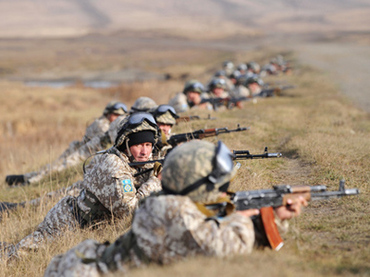
Warsaw Pact, CIS Peacekeeping, CSTO Operations: Moscow Develops “Collective” Intervention Concept (Part One)
Publication: Eurasia Daily Monitor Volume: 8 Issue: 169
By:

Russia’s presidential think-tank, INSOR, has drafted a blueprint for using the Collective Security Treaty Organization (CSTO) as a multinational cover on Russia-led stability operations. Moscow envisions such contingencies in the CSTO’s claimed “area of responsibility” (Belarus, Armenia, Kazakhstan, Kyrgyzstan, Tajikistan, Uzbekistan) and potentially beyond (see EDM, September 8, 9, 14).
Using the CSTO to create the appearance of multinational support for Russian operations would be consistent with Soviet and post-1991 Russian practice. Those interventions took place in countries contiguous to the Soviet Union or Russia. In almost all cases, Moscow went to great lengths portraying its interventions as inspired by collective interests of a group of countries, collectively authorized by such a group of countries, or drawing at least symbolically on their troop contributions.
That pretense never conferred international legitimacy, and seldom helped deflect international criticism from Moscow over such operations. But the purpose of that pretense went beyond propaganda. It served to cast the Soviet Union, or Russia, as leader of a bloc of countries; isolate a target country while creating an appearance of overall consent to Moscow’s hegemony in the region; discourage or pre-empt genuine international involvement in the region’s security arrangements; and reinforce acceptance de facto of Moscow’s unrecognized sphere of influence.
The Soviet Union created the Warsaw Pact with the structure to operationalize it, WTO (Warsaw Treaty Organization, named after the signing venue) as a military alliance against external adversaries in Europe. The WTO, however, was only invoked or used for military intervention in member countries, against independent-minded, popularly-supported governments there. Those interventions also installed governments committed to WTO membership. During the 1990s, Russia used the CIS (then comprised of 12 countries) to bestow “collective” approval on Russian “peacekeeping” operations. The CSTO, like its WTO predecessor and organizational model, is supposed to intervene collectively in the event of external aggression on a member country. However, Moscow proposes to change CSTO’s statutes, so as to use this organization’s cover for Russia-led interventions within member countries, in line with the earlier uses of the WTO and CIS.
In 1956, Moscow had invoked the Warsaw Pact’s mutual assistance provisions as a justification for intervening in Hungary. The Kremlin arranged an invitation from its supporters in that country’s coalition government, and responded by sending in the troops. The military intervention was unilaterally Soviet, but Moscow ensured vocal “collective” support by WTO member governments (Charles Gati: “Failed Illusions: Moscow, Washington, Budapest, and the 1956 Hungarian Revolt,” Stanford University Press, 2006).
In 1968 the Kremlin enlisted troop contributions, on top of political approval, from four WTO member countries, in a “joint” intervention in another member country – this time to suppress the Prague Spring. In this case also, Moscow arranged an invitation from some highly-placed local sympathizers who opposed their government’s policies. The euphemistic label, “Warsaw Pact intervention,” became general official usage in the West (Guenter Bischof et al., eds: “The Prague Spring and the Warsaw Pact Invasion of Czechoslovakia,” Lexington Books, 2010).
The Soviet Union added an elaborate ideological superstructure (“preserving socialism”) to justify those military interventions and replace the ruling teams in those countries. Ultimately, however, those interventions aimed to keep those countries (and, by dint of example, their neighbors) within Moscow’s sphere of dominance. Since (as is often pointed out) “Russia is not the Soviet Union,” Russia easily switched from that Soviet ideological rationalization to other justifications for its military interventions abroad. Already before the Soviet Union’s official demise, Moscow cited goals of social modernization and combating Islamic fundamentalism to justify its intervention in Afghanistan during the 1980s. That intervention remains a rare case of unilateral action, without “collective” contributions from allies.
In 1992, with its internal strength and international credibility at an all-time low, Russia intervened unilaterally again to seize control of Transnistria from Moldova. Although lacking any “collective” support, that action proved enduringly successful and precedent-setting. It became the first Russian military operation under “peacekeeping” colors in the “post-Soviet,” then-evolving “CIS space;” it asserted Russia’s claim to a “peacekeeping” monopoly in that “space” – a claim never seriously contested by the West, indeed explicitly tolerated from the outset; and it demonstrated for the first time the Russian concept of “coercion to peace,” a more fully developed version of which was seen again in 2008 in Georgia.
Its 1992 success in Moldova encouraged Russia in the short term to proceed with further “peacekeeping” operations in Georgia (Abkhazia and South Ossetia) as well as in Tajikistan. Given international tolerance of those operations, Moscow was able to enlist “collective” support in one form or another within the CIS. Aiming to institutionalize such support on a long-term basis, Russia proceeded to create the Collective Security Treaty and, in due course, the structure to operationalize that treaty, CSTO.




